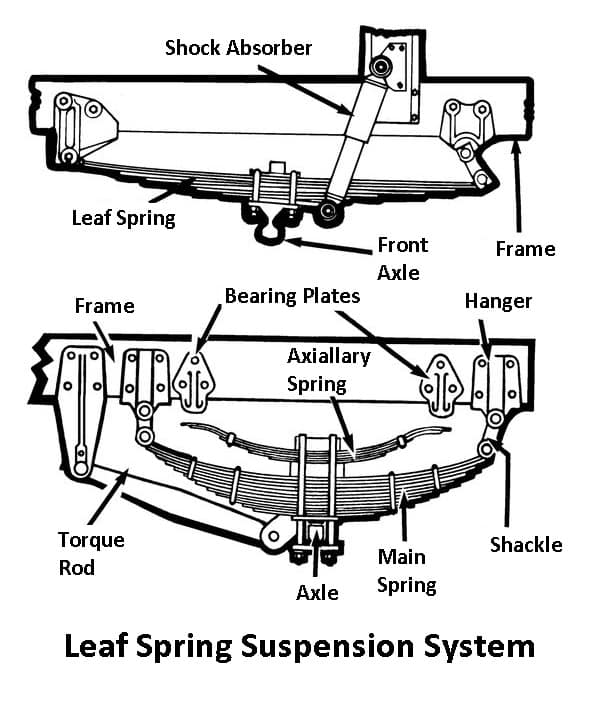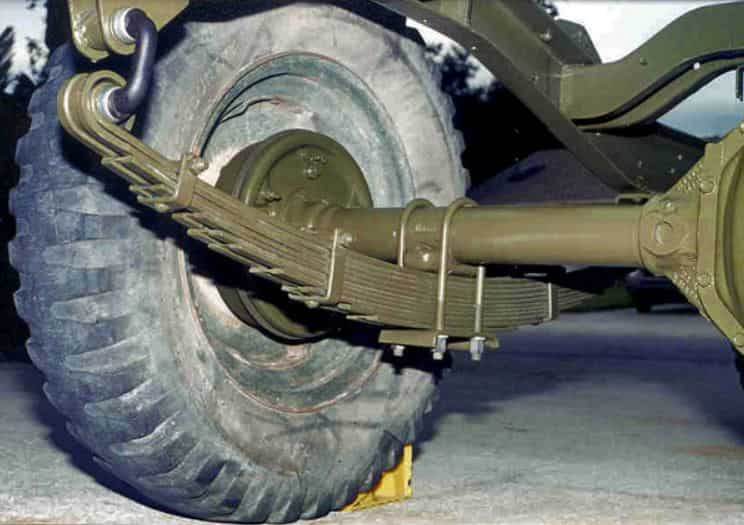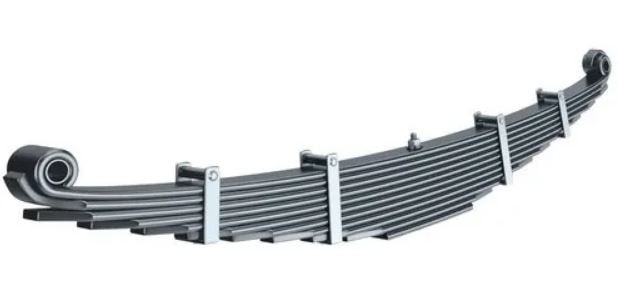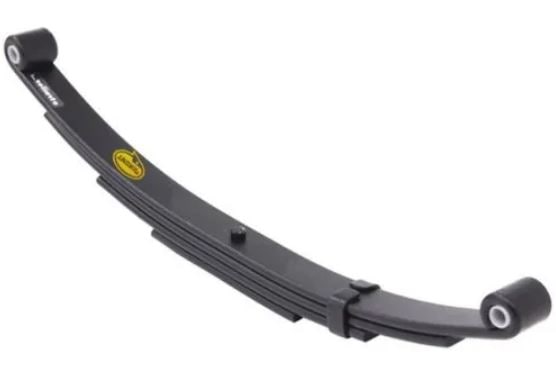In this article, you’ll learn what is Leaf Spring Suspension? Its Diagram, Parts, Function, Types, and Symptoms are explained in detail.
Also, you can download the free PDF file of this article at the end.
What is Leaf Spring Suspension?
Like many car parts, a leaf spring is one of those items on a vehicle that you don’t know until it breaks or is worn out. We have been satisfied for centuries with the luxury of relatively easy transportation due to leaf springs. Without them, you would feel every little bump in the road.
It is a spring made of several strips of metal bent slightly upwards and clamped together on top of each other. Leaf spring is named after a leaf because it is similar to stacking several leaves on top of each other.
A leaf spring is a simpler spring used universally for suspension systems in light and heavy commercial vehicles. For cars, these are widely used for the rear suspension. Sometimes it is also known as a semi-elliptical, elliptical, or carriage spring.
It is one of the oldest spring forms, appearing on trains in France in the 1970s. Leaf springs are most useful for trucks and vans carrying heavy loads. Many trucks from the late 1990s and early 2000s attached the leaf spring to a Hinkle beam ball joint. Furthermore, we have discussed the functions and different types below.
Checkout: What are the Types of Suspension Springs Used In Vehicles?
Parts of Leaf Spring
Following are the main parts of leaf spring:
- Metal plates or leaves
- Master leaf
- Centre bolt
- U-bolt
- Rebound clip
- Spring eye
- Shackle
- Rubber bush

#1 Metal Plates or Leaves
A leaf spring consists of several metal plates, also known as leaflets, layered on each other in decreasing order of their size. The leaves are given a curvature called camber, which gives the leaf spring a semi-elliptic look.
#2 Master Leaf
The longest leaf at the top of the spring is known as the master leaf. It is curved at both ends to form a spring eye. Two bolts are inserted through these eyes to set the leaf spring to the automobile body.
#3 Centre Bolt
The center bolt of the leaf spring is essentially structural integrity. The center bolt is the critical part located in the center of each leaf in a hole. Its task is to hold all the leaves together. It consists of a U-bolt and a central bolt, so the leaves do not fall apart.
#4 U-bolt
Mainly, the U-bolt provides the force required to firmly fasten the leaf spring and associated components together. In addition to the leaf spring, these components include the top plate, axle seat, and bottom plate.
#5 Rebound Clip
Rebound clips are used to keep the leaves aligned and prevent lateral shifting of leaves during vehicle movement. In the center, the leaf spring is supported on the axle. These are steel bands held in a fixed position on either side of the central bolt.
#6 Spring Eye
Most people are unaware of this part. The spring eyes are the loops at the ends of a leaf spring. They fasten to the chassis or axle using shackles or bolts in bushings pressed into them.
#7 Shackle
A leaf spring can be attached directly to the frame at both ends or one end, usually the front, with the other attached via a shackle. When the shackle is compressed, the leaf increases its tendency to spring and thus creates a soft springiness.
#8 Rubber Bush
Leaf spring bushings are used on the front eyes of springs and may be wrapped in steel or maybe all rubber. They provide a cushion for the leaf springs, with the front encased in steel while the rear ones are all rubber.
Read Also: Different Types of Springs and Their Applications
Working of Leaf Spring Suspension
The leaf spring consists of several leaves called blades. The blades vary in length, as shown in the figure. The lengthiest blade has eyes on its end. This blade is called the master leaf. All the blades are bound together through steel straps.
A U-bolt supports the spring on the axle, front, or rear. One end of the spring is mounted on the frame with a simple pin, while on the other end, a connection is made with a shackle.
When the vehicle comes across a projection on the road surface, the wheel moves up, deflecting the spring. This changes the length between the spring eyes. If both ends are fixed, the spring will not be able to accommodate this change of length.
This is provided by employing a shackle at one end, which gives a flexible connection. When the shackle is compressed, the leaf increases its tendency to spring and thus creates a soft springiness.
Read Also: How Does A Manual Transmission System Work?
Need of Leaf Spring

A lot can happen if the load or vehicle weight is too high. The vehicle may start to bounce or shake from side to side. If so, the vehicle being towed is too heavy, and there may be a major problem with the suspension.
When hitting bumps in the road, the wheels will sometimes leave the pavement if the suspension is too stiff. The soft suspension may cause the truck to jump or move.
However, the excellent suspension ensures that the wheels stay on the ground as much as possible while driving. Leaf springs are an excellent option to balance a towed load and confirm that the load remains on the ground.
Read Also: Types of Metals: Their Properties and Applications [PDF]
Types of Leaf Spring Suspension
Following are the main types of leaf spring suspension:
- Multi-leaf spring
- Mono leaf spring
- Semi-elliptical leaf spring
- Quarter-elliptical leaf spring
- Three-quarter Elliptical leaf spring
- Full elliptical leaf spring
- Transverse leaf spring
#1 Multi-leaf Spring

It is a typical spring composed of more than one metal plate or leaf, usually in a semi-elliptical shape. These plates are stacked on top of each other, with the most extended piece on top. A center bolt is inserted via the thickest part to hold the plates in position.
These are designed to provide vehicle support, stability, and protection. Since it has many leaves, spring hardiness increases. The extra support leads to a higher carrying capacity, which is why these are suitable for heavy-duty vehicles. These springs are widely used in cars, trucks, and railway wagons.
#2 Mono Leaf Spring

A mono leaf spring is a fancy main plate without the supporting leaves. This type is made of a single piece of metal. This single leaf acts as a master leaf that has proven that it can be used as a replacement for the existing traditional leaf spring.
They have a thicker center and narrow towards the edges, like a multi-leaf spring, to provide support. These are mainly used on light vehicles.
#3 Semi-elliptical Leaf Spring
These are the most common type of leaf spring suspension systems. It looks similar to the bow and arrow bow but without the strings. It is usually composed of several leaves of varying lengths but the same width. The upper leaf or plate is named as ‘master leaf’.
One end of the semi-elliptic leaf spring is attached to the vehicle’s frame, and the other is fixed to a shackle. This configuration absorbs vibrations caused by irregular road surfaces and provides a comfortable ride. In trucks, they are mounted on the front and rear axles, while on cars, you’ll find them mainly on the rear axle.
#4 Quarter-Elliptical Leaf Spring
It is an older type of spring with a similar structure to the standard leaf spring, only different in that it is halved. Quarter-elliptical leaf springs are similar in construction to semi-elliptical leaf springs but are primarily used in older vehicles.
One end of the spring is attached to the side of the frame via bolts, while the other is attached to the front axle. Nowadays, it is also known as cantilever-type leaf springs.
#5 Three-Quarter Elliptical Leaf Spring
When a semi-elliptic leaf spring and a quarter-elliptic are joined together, a three-quarter elliptical leaf spring is formed. The quarter section is mounted on the axle and attached to the vehicle’s frame.
The semi-elliptical spring is attached to the frame via a shackle on one side, while the other end is attached to a quarter leaf spring. Adding an extra half of this suspension component provides additional support. These types are famous in old vehicles.
#6 Full Elliptical Leaf Spring
It is a combination of semi-elliptic leaf springs that are joined opposite each other to form an oval-like shape. These are attached to the axle and vehicle frame. Since both leaf springs bend the same amount when compressed, spring shackles are unnecessary.
Full-elliptical springs are mainly used in older models. They are rarely seen because they do not maintain correct axle alignment.
#7 Transverse Leaf Spring
This type of leaf spring looks like a semi-elliptical leaf spring. The only difference is that it’s upside down, so the longest leaf is on the bottom.
It is attached to each wheel instead of on top of them. The middle or thickest part is secured through U-bolts. They are also found in older models, often in independent wheel suspensions.
Read Also: Types of Clamps & Their Uses [How To Use Guide]
Advantages
- These springs are a simple and robust solution for carrying heavy loads.
- Leaf springs are light in weight and have good damping action.
- It can handle heavier loads than helical springs.
- It not only serves as a suspension element but a strong connection between the axle and the frame.
- These are the cheapest solution for heavy-duty commercial vehicles.
- It offers the possibility of easy repair, especially in the case of multi-leaf springs.
Disadvantages
- They are not easy to install and are also heavy systems.
- It provides poor driving comfort due to the inter-leaf friction between each leaf.
- As time passes, springs lose shape and can sag. When the sag is uneven, it can change the cross weight of the vehicle, which can affect handling slightly.
- Vibration can be caused by acceleration and braking torque.
Wrapping It Up
In conclusion, a leaf spring’s overall purpose is to support the vehicle. It creates a smooth ride while absorbing bumps or potholes in the road. In addition, leaf springs are used to locate the axle, control the height of the vehicle’s tread, and align the tires to the road.
So now, I expect I’ve covered everything about “Leaf Spring Suspension“. If you still have any doubts or questions on this topic, you can contact us or ask in the comments. If you like this article, then please share it with your friends.
Want free PDFs direct to your inbox? Then subscribe to our newsletter.
Download PDF of this article:
You might like to read more articles on Automobile Engineering: